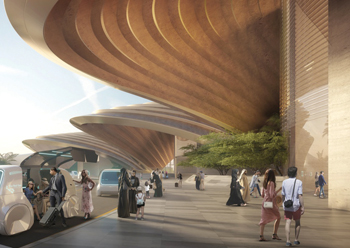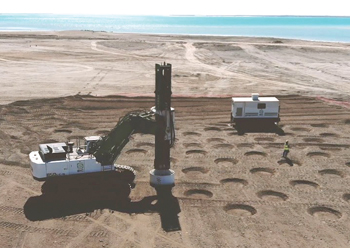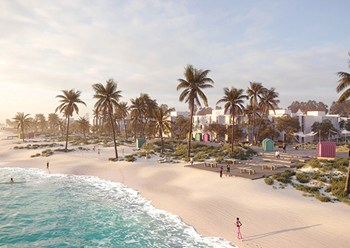Red Sea wonder!
01 May 2020
The Red Sea Project, one of the world’s most ambitious tourism projects that involve the development of several islands along the Saudi west coast, has made impressive progress over the past year in line with its goal of ushering in its first visitors by the end of 2022.
The project, which is envisioned as an ultra-luxury tourism destination for nature, adventure, wellness, and culture as part of Saudi Arabia’s Vision 2030, will be developed around several unique features including 200 km of untouched coastline; over 50 pristine islands and lagoons; thriving coral reefs and marine life; mountains and dormant volcanoes; and heritage sites.
The masterplan has been developed in partnership with WATG and Buro Happold, and includes unique design concepts from some of the world’s most prominent architecture firms.
 |
|
The airport at The Red Sea Project ... designed by Foster + Partners. |
Essential enabling infrastructure is already under way at the destination, with the opening of a base camp that will oversee the installation of temporary roads, jetties and a bridge connecting the hub island to the shore. Also under development is a residential complex for the construction labour force and a management village to coordinate the development work.
Phase One of the project will see the construction of 14 luxury and hyper-luxury hotels across five islands and two inland resorts, providing more than 3,000 hotel rooms. The project will also include a new airport, a yacht marina, leisure and lifestyle facilities, as well as supporting logistics and utilities infrastructure, including 75 km of new roads.
As part of Phase One of the masterplan, The Coastal Village, a residential and commercial area, is being built where infrastructure development work is currently under way, according to The Red Sea Development Company (TRSDC), its developer. This includes the construction of a 3.3-km crossing from the mainland to Shurayrah Island and a 100-hectare landscape nursery that will provide more than 15 million plants by 2030.
Huta Hegerfield and Saudconsulting Services (Saudconsult) have been appointed to undertake a major groundwork improvement project for the Coastal Village. Huta Hegerfield’s scope of works involves land raising and ground improvement for the 1.5-million-sq-m Coastal Village area. This will house the workers, staff and management of The Red Sea Project, and will include corporate offices, housing and high-end facilities.
Saudconsult’s contract includes construction supervision consultancy services, to ensure all elements of the design and construction remain on schedule, whilst observing and monitoring the quality of all construction works, to guarantee that all works are fit for the intended purpose.
Following the completion of the mainland jetty, some 600,000 tonnes of rock have been brought to the project site for the construction of Shurayrah Bridge and more marine jetties, according to the project’s twitter account.
 |
|
Compaction work in progress at the Red Sea site. |
Also, the installation of 10,000 cabins for construction workers is under way. Using pre-fabricated and modular construction reduces delivery time, enhances quality, limits the number of workers on site and minimises the environmental impact of construction, it adds.
According to the Saudi developer, teams on the site are currently raising the ground level to 3.5 m above sea level. Every day, some 10,000 cu m of earth is being transported and about 7,000 sq m of land is being compacted and levelled.
Construction work on the project began in February last year, with the development of the base camp, which is situated on the coastal area near the southern end of the 28,000-sq-km development.
The destination’s international airport is being designed by Foster + Partners. Due for completion in 2022, the airport will serve an estimated one million tourists per year with a schedule of domestic and international flights, and a peak of 900 passengers per hour.
“We’re using passive measures in the design of the airport to minimise artificial cooling as much as possible, so we’re using natural ventilation. Technology plays a significant part. We’re setting new standards for what a future airport can be,” says CEO John Pagano.
Late last year, TRSDC awarded a contract to AlFalah Ready Mix for the supply of structural low-carbon concrete manufactured utilising recycled raw materials to meet existing and upcoming project demand while adhering to its environmental sustainability goals. Approximately 700,000 cu m of concrete will be required for the initial construction work at the destination.
TRSDC has set sustainability targets for the project which include a 100 per cent reliance on renewable energy, a total ban on single-use plastics, and complete carbon neutrality in the destination’s operations.
According to Pagano, TRSDC is leading the way in the use of green concrete for destination-scale development.
In November last year, Binyah, a leading Saudi contractor, was appointed to begin the construction of the coastal and inland road links at the destination. The design-and-build contract for 77 km of roads, includes a 10-km highway, a 13-km airport access road, interconnecting roads within the destination and an access road to the bridge connecting the main hub island. The construction, which is due for completion by the end of Q3 2020, will be closely monitored by TRSDC’s environmental team at all stages of the development, ensuring compliance with the destination’s strict sustainability and environmental guidelines.
All building work will ensure that the area’s sensitive wadi ecosystems are protected and will take place in areas designated as development zones in the marine spatial planning simulation, conducted during the first phase of development.
TRSDC has beein working on identifying the location of its overwater assets, including villas, restaurants and hotel arrival points for two hyper-luxury hotels and one luxury hotel on Sheybarah South and Ummahat Al Shaykh islands.
The destination is expected to be fully completed by 2030, offering 8,000 hotel rooms across island resorts, mountain retreats and desert hideaways.
The Red Sea Project is earmarked by the Public Investment Fund (PIF), the sovereign wealth fund of Saudi Arabia, as a significant driver of domestic and foreign direct investment in the next major luxury global travel destination.
- ‘We shall overcome’
- Red Sea wonder!
- Purity at its heart
- Ports set to expand
- Saudi Projects at a glance



